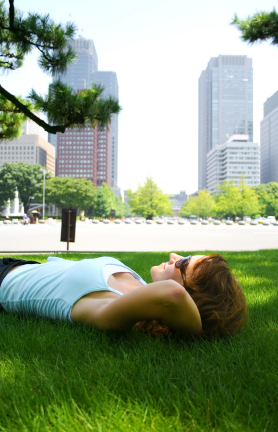
built for a woman, but Ph balanced for a man.
What’s good for the goose is, actually, good for the gander. A progressive European city planning board encouraged women to freely share their opinions and actually took them into consideration– and as a result, revolutionized the modern urban landscape. While American women continue to be denied a voice in the most fundamental aspects of their daily lives, such as legislation regarding health and reproductive care, and wage disparity, Austrians learned that working to accommodate women made things better for everyone.
The Atlantic Cities reports, that in 1999, officials in Vienna polled some residents about their use of public transportation. “Most of the men filled out the questionnaire in less than five minutes,” says Ursula Bauer, one of the city administrators. “But the women couldn’t stop writing.”
Men, they found, hopped in the car or used public transit twice a day, to go to work in the morning and return each night, but women ambled around the city much more on foot and via public transportation, and had a variety of errands and tasks to accomplish.
City planners used their input to draft a plan to improve pedestrian mobility and access to public transit. It was part of a project aimed at taking gender into account in public policy, known in Vienna as gender mainstreaming (rules and regulations that benefit men and women equally, and provide equal access to city resources). According to the report, “More than sixty pilot projects have been carried out to date. As the size and scale of these projects increase, gender mainstreaming has become a force that is literally reshaping the city.”
“Additional lighting was added to make walking at night safer for women,” Atlantic Cities elaborates. “Sidewalks were widened so pedestrians could navigate narrow streets. And a massive staircase with a ramp running through the middle was installed near a major intersection to make crossing easier for people with strollers and individuals using a walker or a wheelchair.”
Similarly, when city officials commissioned a study to see how men and women used park space in the late nineties, they learned that once local girls turned about nine years old, they abruptly stopped hanging out at the parks, while their male counterparts kept on playing in the public spaces. Girls are taught to be less assertive and when they had to compete with boys for park space, they lost. “In 1999, the city began a redesign of two parks in Vienna’s fifth district. Footpaths were added to make the parks more accessible and volleyball and badminton courts were installed to allow for a wider variety of activities. Landscaping was also used to subdivide large, open areas into semi-enclosed pockets of park space. Almost immediately, city officials noticed a change. Different groups of people — girls and boys — began to use the parks without any one group overrunning the other.” Vienna’s park redesign project was nominated for the United Nations Public Service Award.
Eva Kail a gender expert in the city’s Urban Planning Group said her colleagues weren’t always supportive of the projects. “People said things like, ‘does this mean we should paint the streets pink?'” To avoid addressing such tired stereotypes, officials are shying away from the term “gender mainstreaming” to describe their engineering and are instead opting for the wonderfully apt ‘Fair Shared City.’ “For me, it’s a political approach to planning,” Kail says. “It’s about bringing people into spaces where they didn’t exist before or felt they had no right to exist.”
Could the ‘Fair Shared City’ concept work in the U.S.? What suggestions would you share to improve your region?

-300x200.jpeg)









-300x241.jpeg)




